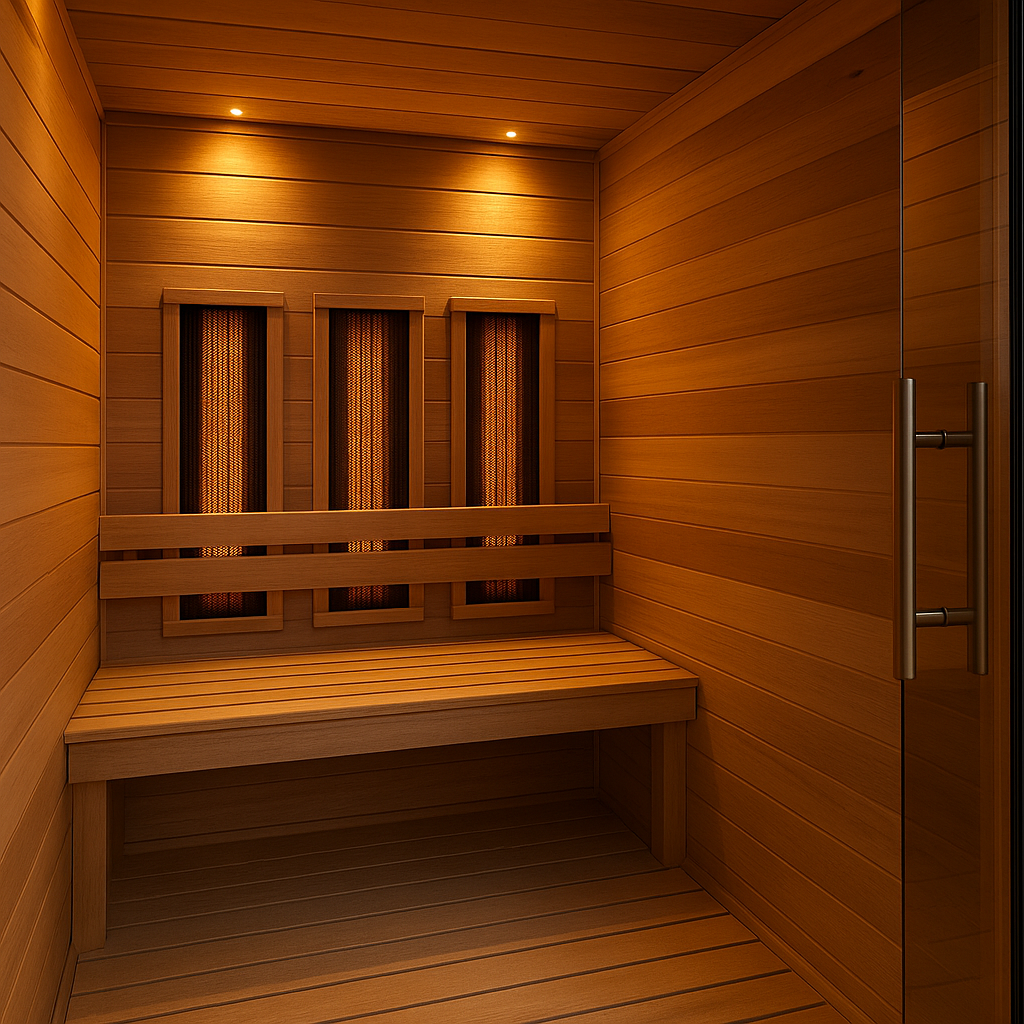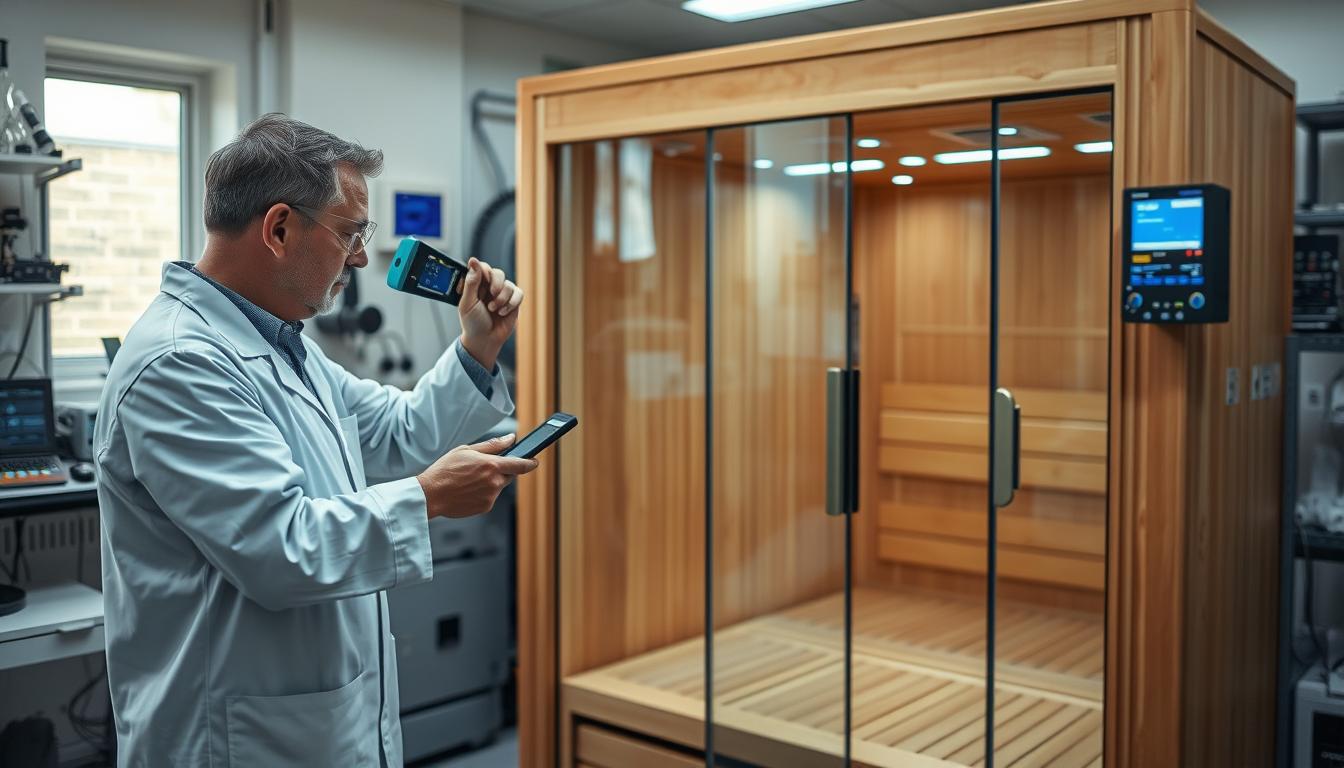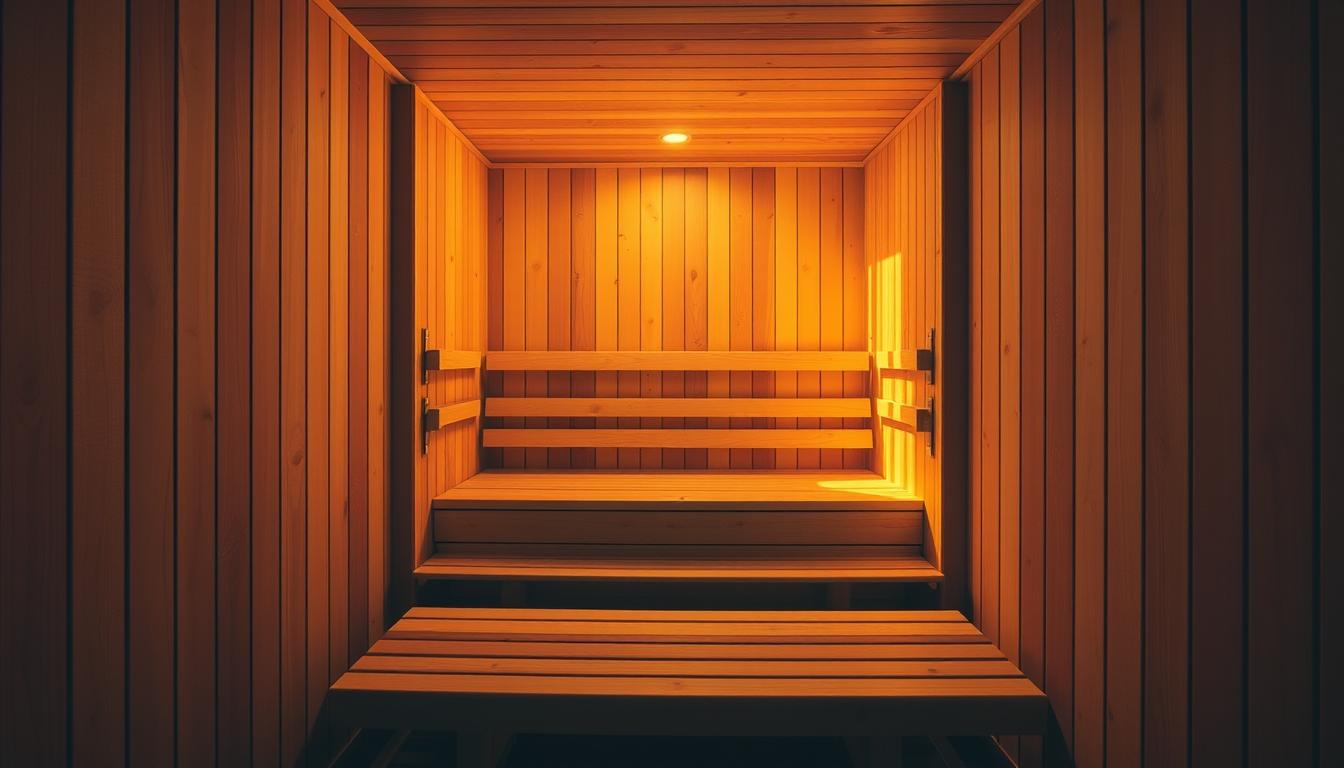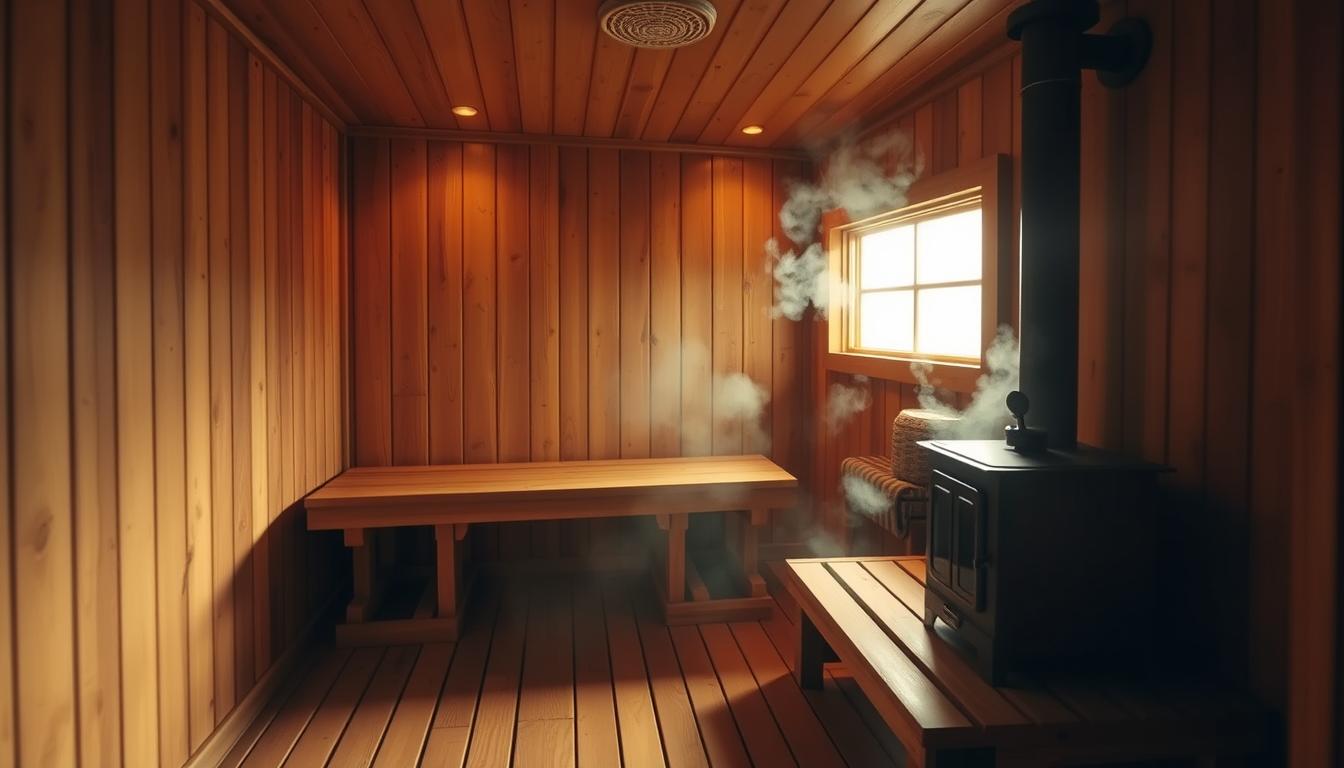
What Is Ultra-Low EMF? Safety Facts For Infrared Saunas
This section explains what an infrared sauna is and why a focus on safety matters. Infrared saunas use non-ionizing electromagnetic energy that does not carry enough power to break DNA or atoms. That basic fact helps people trust the core health claims and review product content with confidence.
Typical sauna readings range widely, from about 2 to 80 milligauss in some traditional set-ups. By contrast, ultra models often measure around 0.30 mG. Nordica’s ultra-low units are designed to measure under 3 mG at about 6–8 inches from the heater panels, a practical distance for real-world reading and comparison.

Key Takeaways
- Infrared saunas use non-ionizing energy that lacks the power to damage DNA.
- Typical sauna readings can range from 2–80 mG; ultra models are much lower.
- Measurements are commonly taken 6–8 inches from heater panels for real-world accuracy.
- Knowing safety facts helps you weigh health benefits and make informed choices.
- Later sections will cover selection, sizes, materials, and warranty details.
Ultra-low EMF defined: how infrared saunas reduce electromagnetic exposure
Understanding how saunas control stray fields helps shoppers compare real-world exposure at the person’s position. In plain terms, non-ionizing fields are low-energy waves that travel at light speed and do not break chemical bonds or harm DNA. This places sauna readings into a clear, science-based context.
https://www.youtube.com/watch?v=3CX1VoFt9G0
Non-ionizing EMF explained
Non-ionizing means low energy. Everyday sources include microwaves, radio clocks, cell phones, and power lines. Emf infrared from wellness appliances is part of that same category, not a different force.
Typical readings and design differences
Traditional sauna units can measure between 2–80 mG. By contrast, ultra low emf designs often average about 0.30 mG at a practical reading point near the user. Smart heater panel layout and careful circuit routing reduce fields at the seat.
- Types such as far infrared and full spectrum are different; both can be engineered for low emf.
- Look for manufacturer content that reports readings at user distance rather than at the panel.
Safety and science: the facts about EMF in infrared saunas
Measured readings at the user position give the clearest picture of exposure during a sauna session.
Measured at the source: under 3 mG at 6–8 inches from heater panels
Nordica’s ultra low models are designed to register a reading under 3 mG when measured 6–8 inches from the heater panels. That practical test point reflects where a person actually sits, not the heater surface. Clear test methods like this show the manufacturer’s commitment to safety and transparent content.

Real-world context: EMF alongside phones, microwaves, and power lines
Non-ionizing fields are common from microwaves, radio clocks, cell phones, and power lines. An emf far infrared session at under 3 mG sits in a familiar range compared with many household sources.
"Compare published readings at user distance, and you get a realistic sense of exposure for people using the sauna."
Comfort at lower heat: why people prefer infrared over traditional steam
Infrared saunas heat at lower air temperatures while still raising core warmth. That results in less humidity and a more pleasant experience for people who avoid high heat.
- Design matters: wiring, shielding, and panel placement drive low emf and consistent levels.
- Look for testing: published readings at the user distance help when you purchase a sauna.
- Ergonomics: bench layout keeps proper distance from panels as part of everyday use.
Health and wellness benefits at ultra-low EMF levels
Reports from sauna users commonly note improved circulation, deeper relaxation, and an exercise-like heart response. These session responses often feel like moderate activity: increased heart rate, vigorous sweating, and post-session energy.

Relaxation and recovery
Sweating and circulation can aid recovery by promoting blood flow and toxin clearance. Many people describe a calm, restorative effect that supports relaxation after busy days.
Pain and joint support
Heat may ease stiffness and general soreness without claiming to treat disease. Anecdotal reports suggest relief for arthritis and daily aches when sessions are regular and moderate.
Cardio, metabolic, and cognitive notes
Sources mention possible support areas such as blood pressure, cardiovascular health, and Type 2 diabetes, as well as cautious links to dementia and Alzheimer’s research. Consult a clinician before using heat therapy for medical conditions.
| Benefit | Typical Response | Practical Tip |
|---|---|---|
| Relaxation | Lower stress, better sleep | Start with 10–15 min sessions |
| Pain relief | Reduced stiffness | Use warm, steady sessions; hydrate |
| Cardio/metabolic | Moderate heart-rate increase | Check with provider if you have conditions |
"Start short and build gradually, prioritize hydration, and listen to the body."
Ultra-low EMF
Engineered circuitry and thoughtful heater layout let a modern unit push stray fields down where the user sits.
Core promise: an ultra low emf unit is built so panel design and wiring reduce field levels at the user position during sessions. This delivers consistent, predictable exposure compared to older designs.

Benchmarks give buyers clear targets. Many designs average about 0.30 mG in real-world tests and can measure under 3 mG at 6–8 inches from the panels. These numbers help you compare levels between models.
Design and materials also affect comfort and performance. Balanced layout, shielding, and quality wiring keep heat even and levels low for daily use.
| Feature | What to expect | Why it matters |
|---|---|---|
| Measured levels | ~0.30 mG average; under 3 mG at 6–8" | Realistic comparison point for shoppers |
| Circuit & panel design | Wiring routing, shielding, panel spacing | Reduces fields at seat; improves heat balance |
| Testing | Published user-distance readings | Verifies manufacturer claims |
Practical advice: compare saunas using the same distance and instrument type. Also consider installation space so the unit fits your routine and delivers the low levels you expect.
"Choose models with published user-distance readings and you gain confidence in both safety and performance."
Far infrared vs. full spectrum vs. near zero: choosing your sauna type
Pick a type that fits how you plan to use an infrared sauna. Start by listing your priorities: steady, deep warmth; a wider wavelength range; or the lowest practical field readings.

Far infrared for deep warmth and low EMF exposure
Far infrared units deliver even, penetrating warmth at comfortable air temperatures. They suit longer sessions and often show strong low emf far performance in published user-distance tests.
Full spectrum options for broader wavelengths and use cases
Full spectrum and full spectrum infrared systems combine heater types to add mid and near wavelengths. This broadens use cases but means reviewing published EMF figures and comfort preferences before you buy.
Near zero models: when you want the lowest possible readings
Near zero designs aim for the lowest measurable fields. These appeal to buyers prioritizing minimal exposure and can appear alongside far infrared and full spectrum options in retail collections.
| Type | Best for | Practical note |
|---|---|---|
| Far infrared | Deep, steady warmth | Good for longer sessions; check emf far infrared readings |
| Full spectrum | Versatile use, varied heat profiles | Compare full spectrum infrared heater mix and published measurements |
| Near zero | Minimal field exposure | Ideal if lowest readings are a priority; verify user-distance tests |
- Match capacity—such as a 1-2 person cabin—to space and session habits.
- Shortlist by goal (relaxation, recovery, sweat) and then compare EMF results, heat-up profiles, and warranty options.
Sizes, capacities, and designs to fit your space
Choosing the right cabin size shapes how often and comfortably you will use a sauna at home or in a facility.
The market ranges from compact 1-2 person units to generous 8 person cabins. A 1-2 person model suits urban apartments and solo routines. A 3–6 person layout fits families. Large 6–8 person cabins are practical for wellness rooms or small business settings.
Popular picks and examples
Consider named models to streamline research. Options include Dynamic Barcelona Elite 1-2 Person Ultra Low EMF Far Infrared Sauna, Dynamic Cardoba Elite 2 Person Ultra Low EMF Far Infrared Sauna, Dynamic Bilboa 3 Person, Dynamic Monaco 6 Person, and Golden Designs Catalonia Elite 8 Person.
Interior comfort and practical checks
Design choices such as ergonomic benches, heater layout, and an optional reading light affect daily comfort.
- Verify external dimensions, ventilation, and door swing before purchase.
- Read reviews for assembly tips, heat-up behavior, and everyday use; collections show “from 277 reviews” as social proof.
- Note availability—Sale or Sold out—and lead times when you plan a purchase.
Balance interior features with far infrared sauna performance to get the heat profile and comfort you want for regular sessions.
Materials, build quality, and heater technology
Materials and heater choices shape how an infrared sauna feels, sounds, and performs over years of use. Pick a cabin that balances sustainable materials with proven heater layout to get steady heat and quiet operation.
Wood options: Canadian Hemlock standard, Cedar upgrade
Most indoor units use reforested Canadian Hemlock. Hemlock heats faster, holds warmth well, and is sustainably sourced. That makes it an efficient, low-maintenance choice for an infrared sauna.
Cedar is often available as an upgrade for aroma and appearance. Cedar keeps panel mounts secure and adds a warm finish for owners who value scent and style.
Heaters and panels: even heat, low EMF, and floor heater add-ons
Heater panels placed for balanced coverage create even warmth and support low emf readings at the user position. An infrared floor heater can improve footwell comfort during long sessions; typical add-on pricing ranges from $219 to $429.
Chromotherapy and ionizers: light therapy and air freshness
Optional Chromotherapy Light (+$99) adds color-based ambiance. An Oxygen Ionizer (+$99) is available for perceived air freshness. Ergonomic sets (+$129 / +$248) increase comfort and practical use.
| Feature | Benefit | Price (add-on) |
|---|---|---|
| Chromotherapy light | Color mood therapy | $99 |
| Oxygen ionizer | Perceived air freshness | $99 |
| Infrared floor heater | Warmer footwell | $219–$429 |
"Evaluate craftsmanship, door hardware, and published emf far infrared tests to match performance with your expectations."
Buying confidence: free shipping, warranty, processing time, and support
Clear purchase terms reduce uncertainty and help buyers plan sauna delivery and setup. The seller provides free shipping across the continental U.S., so shipping costs do not add to the purchase price. Standard order processing is 2–4 business days, a predictable window for planning installation and delivery time.
Order processing and rush options
Standard processing is free and takes 2–4 business days. For faster fulfillment, Rush processing is available for 1–2 business days at +$49. Use rush when you need a quick cart-to-door timeline for a room launch or event.
Warranty tiers and protection
The base warranty is 2 years. Buyers may upgrade to a 3-year plan for +$259 or a 5-year plan for +$369. These options protect your sauna and support long-term use of the unit.
- Returns & guarantees: 30-Day Money Back Guarantee and 100% Price-Match Guarantee give added reassurance for a considered purchase.
- Support: Contact customer support for room-fit, electrical questions, or accessory guidance before you buy.
"Well-structured order steps—confirmation, processing, shipment—reduce surprises and help align delivery with your schedule."
High-demand seasons can extend shipping time, so order ahead when possible. Review return and warranty terms before purchase to understand service logistics and keep the first session stress-free for every person using the sauna.
Social proof and reviews: why customers choose ultra-low EMF saunas
Customer reviews often highlight real-world setup times and the first minutes that shape initial impressions. Across vendor pages, collections show "from 277 reviews" that reflect setup, delivery, and early use.
From setup to first sweat: assembly and first-session minutes
Many people report straightforward assembly steps and clear instructions. Typical assembly takes one to two people and a few hours, depending on model and experience.
New owners note the first minutes after power-on matter. Most mention 10–20 minutes to noticeable warmth and 20–30 minutes to a full sweat for a comfortable infrared sauna session.
What people say about heat levels, relaxation, and pain relief
Common praise centers on even heat, steady warmth, and consistent relaxation that encourages regular use. Reviews for models such as Dynamic Barcelona Elite and Golden Designs Catalonia Elite appear often in positive feedback.
Many customers also share that warmth helped ease everyday pain and stiffness. Statements remain anecdotal and avoid clinical claims, but they reflect real person experiences and repeat use.
- Capacity fit: buyers say matching person sizing to household needs improves satisfaction.
- Early sessions: people learn controls, time the minutes, and dial temperature to personal comfort.
- Vendor checks: read recent reviews for notes on assembly, delivery timing, and customer responsiveness before purchase.
"Reading several reviews helped set realistic expectations for setup, heat, and long-term enjoyment."
Conclusion
Key safety takeaway, non-ionizing fields in an infrared sauna do not damage DNA, and modern units aim for low exposure—often around 0.30 mG on average and under 3 mG at 6–8 inches from heater panels.
Choose a type—far infrared, full spectrum, or near-zero—based on goals and sensitivity. Verify published emf far infrared readings and compare product design, heater layout, and wood options like Hemlock or Cedar.
Select the right person capacity and confirm shipping, warranty, and return terms before you place the unit in your cart. Free shipping and clear processing times make the purchase and delivery simpler for residential or business buyers.
Start with safety data, match comfort features, then buy with confidence.
FAQ
What is ultra-low EMF? Safety and facts
Ultra-low EMF refers to infrared sauna designs that minimize electromagnetic field exposure near the user. These saunas use shielded wiring, low-emission heater elements, and careful component layout so readings close to the panels stay very low. Manufacturers emphasize testing and certification to ensure emissions remain well below common residential sources, supporting user confidence in safety and comfort.
How do infrared saunas reduce electromagnetic exposure?
Infrared saunas reduce exposure through engineering controls: grounded chassis, magnetic shielding, and distance between electrical components and seating. Some models also employ specialized heater technology and filtered power supplies. These design choices lower stray fields while delivering the desired far infrared warming effect for relaxation and recovery.
What is non-ionizing EMF and is it harmful?
Non-ionizing EMF consists of low-energy electromagnetic waves such as those from household wiring, phones, and infrared heaters. Unlike ionizing radiation, these waves do not break chemical bonds or directly damage DNA. Current consensus from major health agencies indicates typical non-ionizing exposures at low levels are not associated with direct tissue damage, though manufacturers still aim to minimize unnecessary exposure.
What are typical EMF readings in traditional vs. ultra-low saunas?
Typical magnetic field readings near older or unshielded infrared heaters can range broadly, sometimes measured between 2–80 milligauss (mG). Ultra-low and near-zero models commonly report readings around 0.30 mG or lower at user distance, depending on measurement method. Independent testing is the best way to verify claims for any specific unit.
How are EMF levels measured at the heater source?
Reliable measurements use gauss meters taken at standard distances, often 6–8 inches from the panels and at seating height. Many reputable makers report values under 3 mG at these points for low-emission models. Look for third-party test reports or in-house measurement protocols to confirm results.
How does sauna EMF compare to other everyday sources?
In real-world context, sources such as cell phones, microwaves, and nearby power lines produce varying EMF levels. Well-designed low-emission saunas typically present lower or comparable readings to many household devices when measured at user distance. Comparing specific meter results helps put exposures into perspective.
Why do people prefer infrared saunas at lower heat compared with steam saunas?
Infrared saunas deliver heat directly to the body via radiant wavelengths, allowing effective sweating and cardiovascular response at lower ambient air temperatures. Users often report greater comfort, longer sessions, and easier breathing versus traditional high-heat steam saunas, making them attractive for relaxation and recovery.
What health and wellness benefits are associated with low EMF infrared sauna use?
At appropriate temperatures and session lengths, infrared sauna use supports relaxation, increased circulation, sweating for detoxification, improved recovery after exercise, and a positive heart-rate response. Many users report reduced muscle and joint discomfort, and some studies suggest benefits for blood pressure and insulin sensitivity. Claims related to cognitive conditions require careful interpretation of the evidence and medical guidance.
Can infrared saunas help with pain and arthritis?
Infrared heat can ease muscle tension and increase local blood flow, which may reduce stiffness and soreness associated with arthritis and general overuse. Responses vary by individual; consistent, moderate sessions are commonly recommended. Always consult a healthcare provider for chronic conditions and treatment plans.
Are there cardiovascular or metabolic benefits such as for blood pressure or Type 2 diabetes?
Research indicates regular infrared sessions can produce transient improvements in blood pressure and may support metabolic health via improved circulation and stress reduction. Some studies show potential benefits for insulin sensitivity, but infrared therapy should complement, not replace, medical treatments for Type 2 diabetes. Discuss use with your clinician.
Do sauna sessions affect cognitive health or conditions like dementia?
Some epidemiological studies link regular sauna bathing (mostly with traditional Finnish saunas) to reduced risk of certain cognitive declines. Evidence specific to infrared, and to low-emission models, is limited. Sauna use may support vascular health, which is one factor in cognitive wellness, but it is not a proven preventive or treatment for dementia or Alzheimer’s disease.
What are the differences between far infrared, full spectrum, and near-zero models?
Far infrared focuses on longer wavelengths that penetrate tissues for deep warming with generally lower EMF profiles. Full spectrum units combine near, mid, and far wavelengths for broader therapeutic use and variable heat sensations. Near-zero models prioritize the lowest possible magnetic field readings through enhanced shielding and component choices. Choose based on desired heat profile, therapeutic goals, and EMF preference.
When should someone choose a far infrared sauna?
Choose far infrared if you want deep, comfortable warmth at lower ambient temperatures and a lower baseline of electromagnetic emissions. These units are often selected for relaxation, recovery, and people sensitive to high-heat environments.
What is a near-zero EMF model and who needs it?
Near-zero models are engineered to deliver the lowest practical magnetic field readings at the seating area. They suit customers who prioritize minimal electromagnetic exposure due to personal preference, sensitivity, or a conservative approach to environmental fields.
What sizes and capacities are available for home and business use?
Saunas range from compact 1–2 person units up to 6–8 person commercial cabins. Solo and couple models are popular for home use, while larger designs serve families, spas, and wellness businesses. Select size based on available space, intended number of simultaneous users, and ventilation needs.
Which models are popular picks for different needs?
Popular models vary by brand and distributor. Well-regarded units often include ergonomic seating, balanced heater layouts, and reliable electronics. When selecting, compare build quality, heater configuration, warranty, and real-customer reviews to match the model to personal goals.
What interior comfort features should buyers look for?
Look for ergonomic benches, adjustable backrests, reading lights, ventilation vents, and thoughtful heater placement for even heat. Small comforts like chromotherapy lighting and integrated sound systems can enhance relaxation during sessions.
What wood options and build qualities are common?
Canadian Hemlock is a common standard due to stability and scent neutrality; cedar is a premium upgrade for natural aroma and durability. Quality cabins use tight joins, kiln-dried lumber, and non-toxic finishes to ensure longevity and a pleasant environment.
What heater technologies are used and can they offer even heat with low emissions?
Infrared heaters come as carbon panels, ceramic elements, or hybrid types. Modern panels are designed for even heat distribution and can meet low-emission goals when combined with proper shielding and layout. Floor or bench heaters are available as add-ons for balanced warmth.
What are chromotherapy lights and ionizers, and are they safe?
Chromotherapy uses colored LED lighting to support mood and relaxation. Ionizers help freshen air by reducing odors and particulates. Both are generally considered safe when integrated by reputable manufacturers and used per instructions.
Do sellers offer free shipping and what are typical processing times?
Many providers include free shipping within the U.S., with standard processing often taking 2–4 business days before carrier pickup. Always confirm shipping terms at checkout, as oversized units may require special freight handling.
Is rush processing available and how long from cart to door?
Rush processing is commonly offered for an additional fee and can shorten preparation to same-day or next-day shipping. Total door-to-door time depends on carrier transit and any required lift-gate or appointment delivery for larger units.
What warranty options and support are typically offered?
Standard warranties often cover 2 years for electronics and structure, with optional 3- or 5-year upgrades available. Look for responsive customer support, clear parts policies, and documented service procedures to ensure a smooth ownership experience.
Are price-match and return policies available?
Many retailers offer price-match guarantees and 30-day money-back policies, subject to return condition and restocking fees. Verify terms before purchase and retain original packaging to simplify returns or exchanges.
How easy is assembly and what can customers expect for first-session setup?
Most modern saunas ship in modular panels for straightforward assembly, often requiring two people and basic tools. Typical setup and first-session preparation takes from 30 minutes to a few hours depending on model and experience. Detailed instructions and online videos usually accompany the unit.
What do customers say about heat levels, relaxation, and pain relief?
Customer reviews frequently highlight comfortable heat profiles, improved relaxation, and reduced muscle or joint discomfort after consistent use. As with all wellness products, individual results vary; reading verified user reviews helps set realistic expectations.







Leave a comment
This site is protected by hCaptcha and the hCaptcha Privacy Policy and Terms of Service apply.